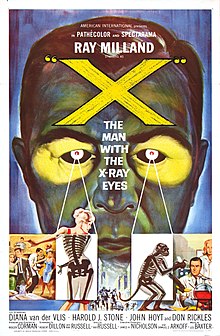X (1963 film)
| X: The Man with the X-ray Eyes | |
|---|---|

Theatrical release poster by Reynold Brown
|
|
| Directed by | Roger Corman |
| Produced by | Roger Corman |
| Written by | |
| Starring | |
| Music by | Les Baxter |
| Cinematography | Floyd Crosby |
| Edited by | Anthony Carras |
| Distributed by | American International Pictures |
|
Release date
|
1971 (France) |
|
Running time
|
79 minutes |
| Country | United States |
| Language | English |
| Budget | ~$280,000 |
| Box office | 53,087 admissions (France) |
X: The Man with the X-ray Eyes is a 1963 science fiction/horror film. Directed by Roger Corman from a script by Ray Russell and Robert Dillon, the film stars Ray Milland as Dr. James Xavier. A world-renowned scientist, Dr. Xavier experiments with X-ray vision and things go horribly wrong. While most of the cast are relatively unknown, Don Rickles is notable in an uncharacteristically dramatic role. Veteran character actor Morris Ankrum makes an uncredited appearance, his last in the movie industry. American International Pictures released the film as a double feature with Dementia 13.
Shot in a mere three weeks on a budget of under $300,000, Corman described the film's success as a miracle. The movie was notable for its use of visual effects to portray Dr. Xavier's point of view. While crude by later standards, the visuals are still effective in impressing upon the audience the bizarre viewpoint of the protagonist.
Dr. Xavier develops eyedrops intended to increase the range of human vision, allowing one to see beyond the "visible" spectrum into the ultraviolet and x-ray wavelengths and beyond. Believing that testing on animals and volunteers will produce uselessly subjective observations, he tests the drops on himself.
Initially, Xavier discovers that he can see through people's clothing, and he uses his vision to save a young girl whose medical problem was misdiagnosed. Over time and with continued use of the drops, Xavier's visual capacity increases and his ability to control it decreases. Eventually he can no longer see the world in human terms, but only in forms of lights and textures that his brain is unable to fully comprehend. Even closing his eyes brings no relieving darkness from his frightening world, as he can see through his eyelids.
...
Wikipedia
